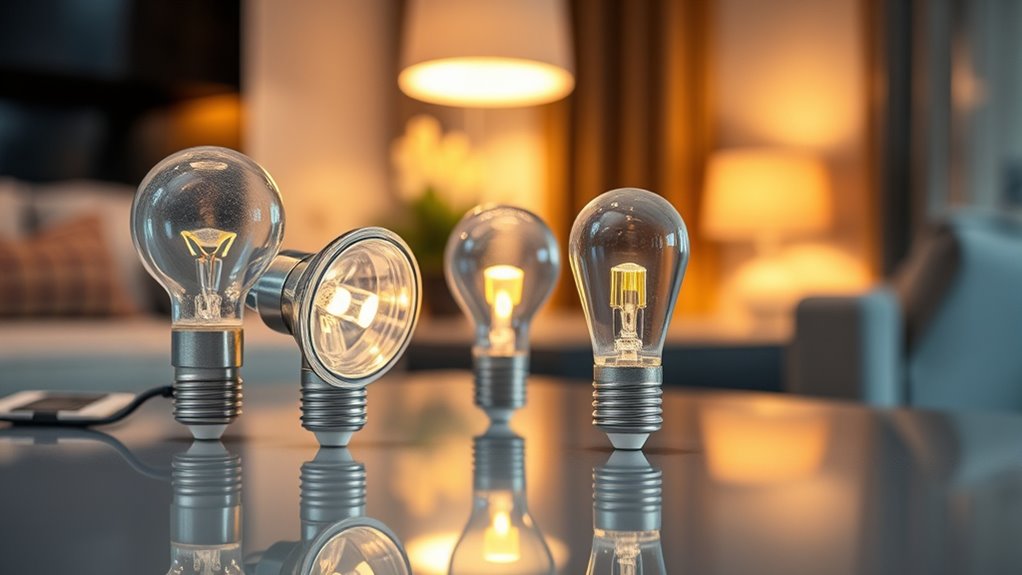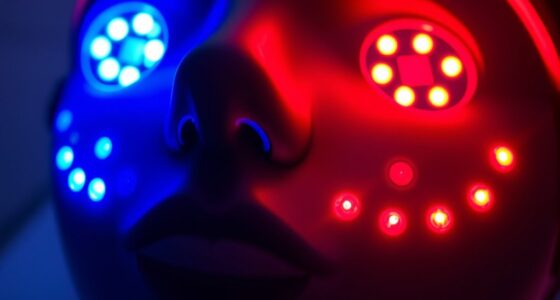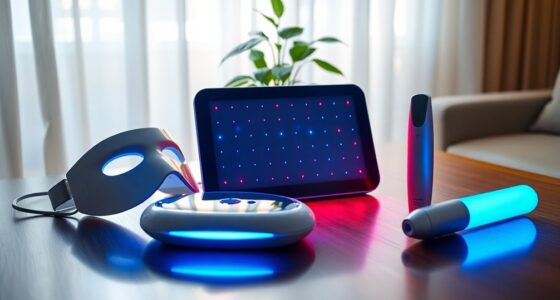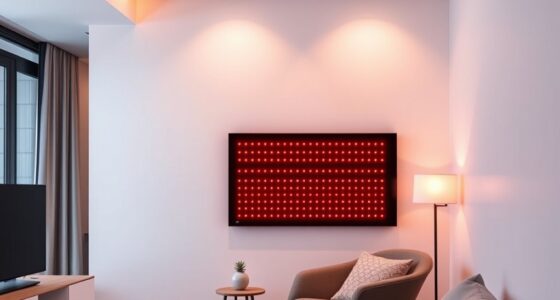To guarantee your home LED units protect your eyes, look for products with safety certifications like UL or CE, which verify they meet safety and blue light standards. Check if they have blue light filters or use warmer color temperatures to reduce eye strain and minimize long-term damage. Properly certified LEDs help you avoid risks like eye fatigue and retinal harm. Keep exploring to discover how selecting the right LEDs can keep your eyes safe every day.
Key Takeaways
- Look for certifications like UL, CE, and Energy Star to ensure LED units meet safety standards.
- Verify the product’s blue light emission levels and presence of blue light filters for eye protection.
- Choose warmer color temperatures for relaxing spaces to minimize blue light exposure.
- Proper labeling indicates compliance with regulations that reduce risks of digital eye strain and retinal damage.
- Selecting certified LEDs with safety features supports long-term eye health and safe home lighting.

Blue light hazards are a primary concern with LED lighting. This high-energy visible light can penetrate deep into your eyes, potentially causing discomfort, digital eye strain, or even contributing to long-term damage like retinal issues. It’s vital to look for LED units that minimize blue light emission, especially if you spend extended periods under artificial lighting or use LED fixtures near screens. Manufacturers often address these concerns by incorporating blue light filters or reducing the blue light spectrum in their products, but verifying these features through certification labels is key. Additionally, understanding the blue light spectrum and its effects can help you choose lighting that is safer for your eyes during prolonged use. Eye safety certifications serve as a reliable indicator that the LED products meet established safety standards. Certifications such as UL (Underwriters Laboratories), CE (Conformité Européenne), or Energy Star ensure the lighting units have undergone rigorous testing for electrical safety, flicker rate, and blue light emission. These certifications not only guarantee the product’s safety but also reflect compliance with regulations aimed at protecting consumers from potential eye hazards. When selecting LED lighting, always check for these labels on the packaging or product specifications. Furthermore, understanding the specifics of eye safety standards helps you make informed decisions about the lighting intensity and color temperature suitable for different areas of your home. For example, warmer color temperatures tend to emit less blue light and are better for bedrooms or relaxing spaces, while cooler temperatures might be appropriate for workspaces but require caution regarding blue light exposure. By choosing LEDs with appropriate certifications and color specifications, you can reduce eye strain and safeguard your vision.
Frequently Asked Questions
Are LED Eye-Protection Standards Consistent Across Different Countries?
You might wonder if LED eye-protection standards are consistent worldwide. While some international guidelines promote safety, regulatory divergence exists across countries, leading to variations in standards. This means that what’s acceptable in one country might not be in another. As a consumer, you should verify local regulations and product certifications to guarantee your LED units meet appropriate safety standards, especially regarding eye protection.
How Often Should Home LED Units Be Inspected for Safety Compliance?
You should follow a regular maintenance schedule and conduct safety inspections of your home LED units at least once a year. This safety inspection frequency ensures your LED lights remain in good condition, preventing potential hazards. Check for signs of wear, damage, or malfunction, and clean the units to maintain peak performance. Staying consistent with these inspections helps protect your eyes and ensures your lighting setup remains safe and effective.
Do Eye-Protection Standards Evolve With New LED Technology?
Think of eye-protection standards as evolving like a river, always flowing with new discoveries. As LED technology advances, especially with blue light and flicker reduction, standards are updated to keep pace. These changes guarantee your eyes stay protected from potential harm. So, yes, eye-protection standards do evolve with new LED tech, adapting to address emerging concerns like blue light exposure and flicker, helping you enjoy safer lighting at home.
Can Improper Installation Compromise Eye Safety in LED Lighting?
Improper installation can definitely compromise eye safety in LED lighting. Installation hazards like exposed wiring or incorrect fixture placement can lead to direct or reflected glare, harming your eyes. That’s why user awareness is vital; you should follow proper guidelines and avoid shortcuts. Ensuring correct setup minimizes risks, protecting your eyes from potential damage caused by intense or improperly directed LED light. Always prioritize safety during installation.
Are There Specific Certifications Indicating Compliant LED Units?
Think of certification labels as the safety gates for your home lighting. When you see labels like UL or IEC, they’re your assurance that the LED unit meets safety guidelines. These certifications indicate compliance with standards designed to safeguard your eyes, preventing potential harm. Always choose LED products with proper certification labels to ensure your lighting is safe, reliable, and adheres to established eye-protection standards.
Conclusion
By understanding eye-protection standards, you safeguard your vision and embrace a brighter, safer home environment. Don’t let overlooked details cast shadows on your well-being—think of these standards as a shield, guarding your future sight. When you prioritize safety, you’re not just protecting your eyes; you’re illuminating the path to peace of mind. So, take action today—because your eyes deserve the brightest, safest light of all.









